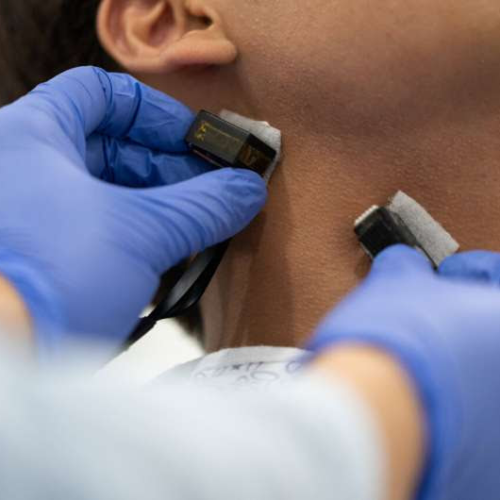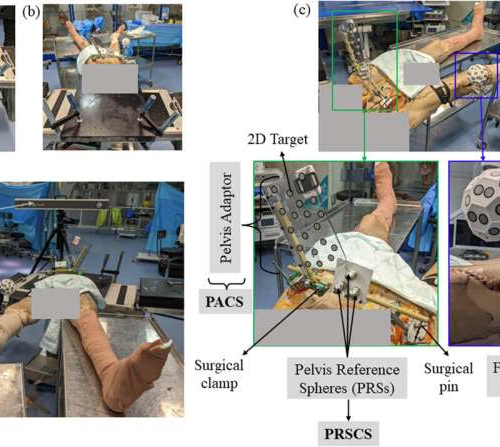News Release 30-Jul-2024 Peer-Reviewed PublicationPNAS Nexus image: Acoustic stimulation paired with ultrasound imaging reveals resonance properties of an artery. (A) Device placement to measure blood pressure in the carotid artery. (B) Illustration of device operation: Ultrasound transducer (gray probe) is used to generate images of the artery (at bottom). (C) Illustration of resonance sonomanometry. Credit:...
Tag: <span>biomed tech</span>
Non-invasive device uses magnetoneurography to record involuntary nervous system
July 29, 2024 by University of California – San Diego A researcher holds an Optically Pumped Magnetometer. Researchers have used these non-invasive devices to record, for the first time, activity in human cervical nerves. Credit: Qualcomm Institute/UC San DiegoA research team led by UC San Diego has, for the first time, shown that a wearable,...
‘Mini lungs’ research leads to multiple COVID-19 discoveries
JULY 23, 2024 by Sanford-Burnham Prebys hiPSC-derived LOs are susceptible to infection with multiple strains of SARS-CoV-2, validated in primary human lung epithelia. Credit: Proceedings of the National Academy of Sciences (2024). DOI: 10.1073/pnas.2408109121Scientists at Sanford Burnham Prebys, University of California San Diego and their international collaborators have reported that more types of lung cells...
First long-term study shows use of socially assistive robot improves stroke rehabilitation
JULY 24, 2024 by Ben-Gurion University of the Negev The experimental setup. A. Participant in the ROBOT group. The social robot Pepper gives instructions and feedback to the patient, which are presented both on the robot’s tablet screen and verbally. B. Participant in the COMPUTER group. The instructions and feedback are presented both on a...
Researchers develop new transparent ‘blood vessel-on-a-chip’
SCIENCE & TECHNOLOGY NEWS Researchers have developed a ‘blood vessel-on-a-chip’ for heart disease with the potential to change the future of drug testing and development. The technology could also reduce our reliance on animal testing. An example of the transparent blood vessel on a chip. Image credit: University of Sydney A University of Sydney team...
From Dr. Oz to heart valves: A tiny device charted a contentious path through the FDA
JULY 15, 2024 by David Hilzenrath, Holly K. Hacker, KFF Health News MitraClip. Credit: Wikimedia Commons Hellerhoff Creative Commons Attribution-Share Alike 3.0 Unported license.In 2013, the FDA approved an implantable device to treat leaky heart valves. Among its inventors was Mehmet Oz, the former television personality and former U.S. Senate candidate widely known as “Dr....
Abbott warns that some of its blood sugar monitors may need replacement due to incorrect readings
July 25, 2024 by The Associated Press This image provided by Abbott shows how to identify the lot or serial number on a FreeStyle Libre 3 glucose monitors to determine whether the sensor inside is one of those being recalled by the company, Wednesday, July 24, 2024. The medical device maker said some sensors on...
Samsung finally puts a health tracker on your finger with the Galaxy Ring
By Paul RiddenJuly 10, 2024 Samsung jumps into the health-tracking ring arena with the official launch of the Galaxy RingSamsung Samsung has finally pulled back the official curtain on possibly its worst kept secret – the Galaxy Ring health tracker. Though there have been a number of similar wearables available from smaller companies for a...
Advanced technology could give us ‘personalized’ hip replacements
JULY 11, 2024 by University of Warwick Experimental set-up for the cadaver experiment. (a) A specially designed fixation plate is used to position the cadaver specimen. (b) The cadaver specimen is secured to the fixation plate using a C-clamp, and the fixation plate is clamped onto a height-adjustable table. (c) ‘Pelvis Adaptor’ and pelvis reference...
All stem cell therapies are not created equally: Some don’t have many stem cells at all, researchers find
JULY 12, 2024 by University of California – San Diego Credit: Pixabay/CC0 Public Domain Researchers from University of California San Diego have found that two of the most frequently administered stem cell therapies, which are often used interchangeably, actually contain completely different types of cells. The results challenge the current “one-cell-cures-all” paradigm in orthopedic stem...










